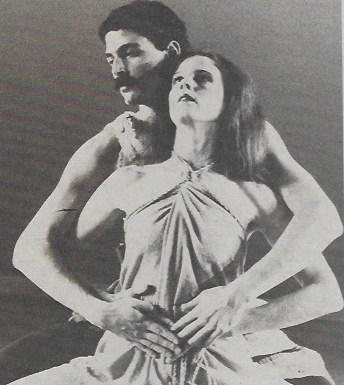The third piece that Irving Fleet and I collaborated on was called Sarah. I mentioned it in the blog about the beginning of the New York company and want to go into more detail about the piece in this blog. Irving is quoted in an article in the Tallahassee Democrat as saying, “JoAnne was always intrigued with the character of Sarah” (March 2, 1979). And I hunch that was probably what motivated us to begin exploring her story. We honed in on that part of her life centered on first being unable to bear a child for her husband, then offering her handmaiden, Hagar, to bear a child for her and finally, when she becomes pregnant, Abraham celebrating the news. For me this was the beginning of my own journey creating “dance midrash.” Midrash refers to both the early interpretations and commentaries on Torah as well as modern ones. At the time I didn’t know this word. Later I would create a number of dance pieces that I considered midrash, co-author a book on dance midrash (Torah in Motion: Creating Dance Midrash, with Rabbi Susan Freeman), and teach many workshops involving dance midrash.
While telling the story was somewhat important, it was exploring Sarah’s emotions that we focused on the most: Sarah’s anguish at not becoming pregnant; her jealousy and anger at Hagar when Hagar does bear a child for Abraham, which results in Sarah banishing Hagar; and then her joy when she becomes pregnant in her old age.
Ritual movement again played an important choreographic role in the piece. When Abraham renews his covenant with God following news of Sarah’s pregnancy, Sarah, in our midrash, takes off the rope from her gown and gives it to Abraham. He then uses it for tefillin (ritual leather boxes with straps, which contain Torah text). Tefillin are traditionally only worn by men during the weekday morning service. They wrap one set around the arm, hand and fingers, and wrap the other set above the forehead. As Abraham is often referred to as the father of the morning prayer this ritual seemed an appropriate one to draw on. In the same article in the Tallahassee Democrat that I referred to earlier I am quoted as saying, “Dance composition should go back to everyday gestures, take them, enlarge and manipulate them.” And that is exactly what I did with the ritual of wrapping tefillin. I thought it worked very well. However, not everyone agreed with me. In fact, we had received some funding that year from the National Foundation for Jewish Culture and when the piece was later performed in New York City, the Executive Director from the NFJC made a very strong point of letting me know that I clearly didn’t understand what wrapping tefillin was, as it was entirely inappropriate for Sarah to hand Abraham the rope from her gown to use. Indeed I did very much understand and part of my feminist statement was purposefully to have Sarah hand it to him.
On Saturday March 3, 1979, the first performance of Sarah was held as part of a concert at Temple Israel in Tallahassee along with Sabbath Woman, In Praise and I Never Saw Another Butterfly. The piece was created on the Tallahassee company with Ellen Ashdown as Sarah, Michael Bush as Abraham, Judith Lyons as Hagar and two handmaidens, Donna Campbell and Trish Whidden.

March 2, 1979.
Six weeks later I recreated the piece for the New York company with Lynn Elliott dancing the role of Sarah in a performance at Hebrew Union College – Jewish Institute of Religion’s West 68thStreet Campus.
In the fall of 1979, we did a three-week season at Henry St. Settlement House on the Lower East Side of New York City as part of the American Jewish Theater. This was an excellent experience for us and I will write a full blog about it. For right now I want to share part of a review from Dance Magazine (by Marilyn Hunt) of the performance of Sarah at Henry St.
Sarah, a Grahamesque drama of a woman of large-scale passions is portrayed concisely and lucidly. Sarah vents her despair at being childless by lashing one leg around, pacing, and whipping her hair in a circle. In contrast, her handmaiden, young Hagar, whom Sarah gives to her husband, Abraham, to bear him a child, carries her imaginary water jar with chest thrust proudly forward and has a formal ritual-like mating with Abraham. Only the ending, God’s promise that Isaac, Abraham and Sarah’s belatedly-born son, would father the tribes of Israel, failed to come across in dance terms. The two women’s roles were especially well filled by Lynn Elliott and Peggy Evans. Dance Magazine, February 1980.
A year later when Rick Jacobs, who was then a rabbinic student at HUC-JIR, joined the company and learned the part of Abraham, the ending blessing took on a whole new dimension, as the prayer and actual movement were already deeply meaningful to him, and he performed the section in a uniquely heartfelt way.


Sarah continued to be beautifully performed regularly by the New York company during the next several years with Rick dancing the part of Abraham, and Lynn Elliott dancing the part of Sarah. For me Sarah was the first of a series of pieces focusing on Biblical women. And I would revisit Sarah, more than once.
[print_link]
Links to Recent Blogs
[catlist name=name of category]

